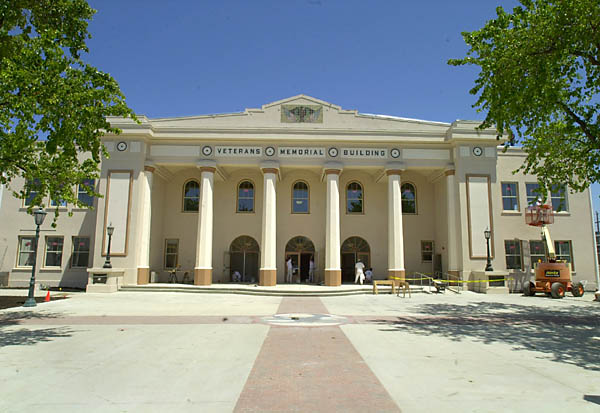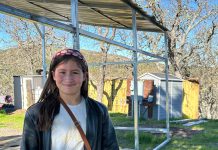When David and Ravena Huboi took on the architectural task to
restore the 75-year-old Veterans Memorial Building, they couldn’t
have imagined its immense scope.
Now, after more than two years of deadlines and escalating
tensions that came with the project’s expansion, the product of
their labor, what many believe is a triumph stands complete and
will be given back to the community during the rededication
ceremony at 11:45 a.m. Monday.
When David and Ravena Huboi took on the architectural task to restore the 75-year-old Veterans Memorial Building, they couldn’t have imagined its immense scope.
Now, after more than two years of deadlines and escalating tensions that came with the project’s expansion, the product of their labor, what many believe is a triumph stands complete and will be given back to the community during the rededication ceremony at 11:45 a.m. Monday.
As owners of Huboi Architectural Services, David is the local firm’s chief architect, and Ravena the interior designer. The couple, married 15 years ago, held responsibility for the $4.4 million renovation of the veterans hall.
Free Lance: When did you first learn of the renovation, and how much did you want this contract?
David Huboi: I recall reading about it in a local newspaper. They were advertising for putting this project or describing this wonderful building that was in need of a lot of care and attention. They were looking for an architectural firm to do an evaluation of the building, the different systems and to do a cost estimate.
Ravena Huboi: At that time, the feasibility study was partially for the city to determine if they wanted to get the building from the county. At that time, the county owned it.
We had interest in historic renovations, so we wanted it very much. We wanted it badly to continue getting known for that. And also, because it was a city project, and that’s important to us.
FL: What were some of your thoughts during those initial stages of surveying?
DH: After we got more acquainted with the building, we went into all the spaces. What really stood out were all the momentos – the old souvenirs and photographs on the walls. We were in awe of all the displays on the wall that were saying, ‘This is indeed a building of history.’
RH: Nobody had really been upstairs in years. It was all sealed off, and they had two sides of the building – one for the American Legion and one for the Veterans of Foreign Wars.
It was just awesome to see all this life and history that had gone on in there. It was a big project. I think that hit us too because the building was in pretty bad condition.
DH: We knew it was going to be quite a task to tie it all together because of all the modifications that had gone on in that building over the years.
FL: How much collaboration was there between all the firms and agencies involved?
DH: We had to assemble some 17 different engineers and consultants on our part to do our designs. From there, from the coordination of the design team, we had to coordinate with the project manager, Harris and Associates, the building department, the public works department, and a minor degree with the planning department, but also with the state Office of Historic Preservation.
RH: And the Parks and Recreation Department. Robert (Ornelas) was at almost every meeting, because they’re the user.
DH: We had to also coordinate with the county Board of Supervisors. They denied us making any access during the evaluation. They denied us making any cuts or any accesses in the building. We had to extrapolate during the design phase. That’s a big two-cent word that means we had to make a reasonable prediction based on what’s known data.
FL: I know you’re passionate about this building project. Talk about how that pride has grown since starting.
DH: It was a tremendous honor, and I feel a tremendous sense of pride for the City of Hollister to have given us a vote of confidence to participate on such a noble task. But it’s not just the pride.
When I think about the veterans, I think about the commemorative pavers (Remembrance Tiles), the monuments and what an important building it is, a sense of emotion wells up inside me.
RH: Part of the reason they wanted to use a local architect is because we have a lot of pride because we live here. It’s been overwhelming at times because it’s very important to us that it turns out absolutely perfect, because we live here, and everybody knows us.
FL: How important was historical preservation in this design?
DH: Before buildings were classified as historic, a lot of them were either bulldozed or left in a state of disrepair to eventually disintegrate and collapse to demise. In the case of our Veterans Memorial Building, it’s not just renovating and restoring the building, but it’s preserving a legacy for future generations.
FL: You have a relative who died in the line of duty. How much does that play into your feelings on this building and veterans issues?
DH: My uncle, who I intend to say a few words about at the rededication ceremony, is a man I never met, but whose photograph I see every day perched on my desk, and whose name is engraved in one of the commemorative pavers. He gave his life helping his buddies out of a spiraling B-24 Liberator that had been damaged by flack. He was 19 years old. Each of the names engraved on or around the monuments have their own story to tell.
RH: That was very important to David – the pride of being involved in a memorial to veterans.
DH: When I saw the movie “Saving Private Ryan,” the beach scene where the young men were killed, I realized how fortunate I am, to have raised a family, and to be able to design buildings and make choices in my life, when there are these young men who really never had a chance at life, who gave their lives for the cause of freedom. So that to me is something I have to keep and remember for the rest of my life, and be grateful for the freedoms I have.
RH: You (speaking to David) mentioned to me, too, that you detected a lot of pride from the people working on the building, a lot of pride from the workers that are out there. They’ll comment, especially after 9-11, that they’re proud to be working on it, and it’s meaningful to a lot of them.
DH: It’s remarkable that you go out there to your regular construction meeting, you walk around the site, you talk to the workers out there. It’s like a magic in the air during what’s going on with our country. It’s a magic that makes this more than a construction project, but more of a mission, a mission from a higher calling.










